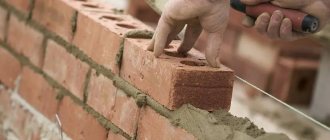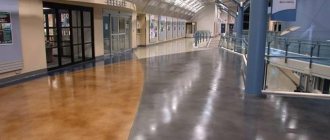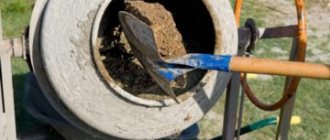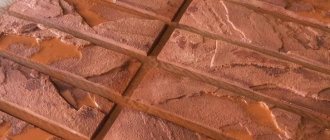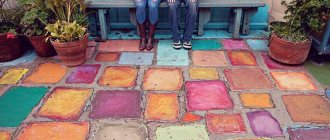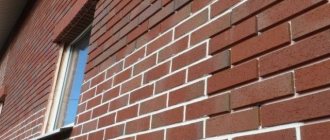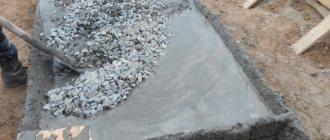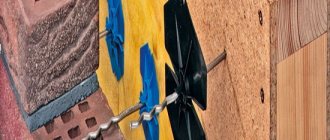Table of proportions of adding pigment to dry cement
| Pigment color | Minimum ratio, % | Sufficient % to obtain rich color | Maximum amount, % |
| 1 | 3-4 | 5 | 5 |
| 0,2 | 1-2 | 3 | 3 |
| Green | 0,2 | 1-2 | 3 |
| Orange and yellow | 2 | 3-4 | 5 |
| Brown | 2 | 2-3 | 5 |
| 2 | 4-5 | 5 | 5 |
| Red | 1 | 1,5-2 | 5 |
HLV brand coloring additives for garden paths and borders differ in their application; additives can be used at any stage of mortar production or on ready-made paths by applying the dye on top of the concrete. The dye is added from 0.2 to 3% by weight of dry cement, the recommended proportions are 250 g of dye per 25 kg of cement.
What coloring additives and pigments have in common is their range, which most often consists of 4 colors: red, brown, yellow and green.
Dyes for solution
Until recently, there were no special requirements for the appearance of houses and other reinforced concrete products. Nowadays, concrete pigmentation is an essential component of the technology for the production of a huge range of products for construction and finishing works. Therefore, already at the stage of producing the solution, ready-made pigments are added to it, giving beautiful shades.
Characteristics of additives for the working mixture
Paints are diluted with solvents. For this purpose, you can use the following substances - white spirit, acetone, for acrylic colors - water. The important properties of pigments are:
- fraction size – the smaller the particles, the better the coloring result, as well as the more effective the ability to cover the gray shade of the base,
- resistance to light - special additives in the composition extend the life of the paint and do not allow it to quickly fade in the sun,
- inability to soak in water and oils.
Dry (powder) paints for mortar have excellent coloring ability and optimal granulometric composition. Most pigments are heat-resistant, can withstand temperatures of more than +500 degrees, and practically do not react to atmospheric influences. They are used for preparing various types of concrete solutions, as well as for coloring ready-made ordinary and mosaic concrete. Pigments are introduced at the mixing stage or spread over fresh concrete (rubbed in with a spatula).
Liquid pigments are used for intensive, uniform coloring and giving the structure of artificial stone. They are also UV- and weather-resistant, their price is much higher, but the color range is richer.
Advantages and disadvantages of the painted composition
The use of pigments during mixing of the solution is considered preferable among professionals, since the entire mass is colored. Even cutting hardened concrete will not cause any complaints, because all the parts will look uniform in color. When the surface is abraded, the overall color will not change, which is a huge plus.
Here are other advantages of a cement-based colored composition:
- giving an original decorative look,
- wide range of shades,
- the opportunity to realize a design idea,
- reduction in cladding costs,
- safety for humans, nature,
- cost savings due to low pigment consumption,
- very rich color.
The method also has disadvantages. Due to the influence of the sun, even the most UV-resistant pigment turns a little yellow over time. Also, the use of pigments compared to the use of unpainted concrete will increase construction costs. Another disadvantage is the labor intensity of the work if you have to mix large volumes of colored concrete.
Methods for coloring cement mortar
There are several technologies that allow you to give concrete the desired color:
- introduction of one selected pigment into the finished composition with subsequent pouring of the floor, structures,
- adding different pigments (the method is more often used for filling tiles or other small products),
- introducing different shades of the same color and creating the structure of artificial stone (with veins),
- painting the form for pouring and then pouring unpainted concrete into it.
New technologies
The newest and most labor-intensive methods of painting concrete with pigments are used mainly by professionals. Specialists create concrete that is similar in texture and appearance to various stones - natural and artificial. To do this, different shades of pigments are mixed to obtain secondary tones - bright green, lemon, cherry, burgundy and others. In artisanal conditions, it is very difficult to achieve such an effect; professional equipment is required.
Preferred types of cement
To color concrete, you can use any brand of cement, there are no restrictions. And yet the result will depend on the quality of the material, because not only the pigment determines the final effect. For the brightest colors, white, expensive cement is used. If muted tones are acceptable, you can buy cheaper gray Portland cement.
What should I do if I purchased only dark (gray) material? You can give concrete blue, dove, green, black, brown colors by adding appropriate pigments. The easiest way is to make a shade of wet asphalt from this composition. White cement will produce pink, blue, beige concrete when the necessary pigments are combined.
Selecting a shade
Most often, the following pigments are used in coloring concrete or to create secondary shades:
- green – chromium oxide,
- white – titanium dioxide,
- red – red iron oxide,
- yellow – yellow iron oxide,
- black – soot or carbon monoxide,
- brown – brown iron oxide.
Using such pigments, you can create other tones that are also used to color concrete mortar. The use of some dyes, on the contrary, is not economically profitable - they quickly lose their primary color in the sun (for example, blue phthalocyanine).
Recommendations for the master
All pigments should be sifted before adding to the solution. If there are large particles in the product, you need to get rid of them. Otherwise, dark veins will appear in the concrete mass. Liquid dyes are filtered. It is necessary to add pigments to the solution until it acquires the required color, but not exceeding the maximum allowable amount.
Other tips for beginners:
- To get a rich tone, you should mix different pigments,
- before painting hardened concrete, it must be washed thoroughly and all fat removed, otherwise the quality of work will be poor,
- The solution prepared with the addition of pigment must be allowed to stand for several minutes so that the coloring substances are completely dissolved.
Strengthening additives for concrete
To ensure that the path is not only beautiful, but also durable, you can use concrete additives that increase the strength of concrete and resistance to mechanical stress.
Today there are a sufficient number of various additives and hardeners, for example, a liquid inorganic compound based on lithium. This hardener is applied to the finished concrete product, it penetrates 3 cm deep into the pores of the concrete, it crystallizes in the pores and thereby increases the strength of the concrete.
In addition to impregnation, you can use additives that are mixed with liquid concrete solution, for example, polypropylene fiberglass is used for micro-reinforcement of concrete, which will make your paths even stronger and more durable.
In addition to impregnations, there are also ready-made additives that are recommended specifically for creating garden paths from concrete, for example HLV-15.
← Previous material
Next material →
How to properly dilute pigment for concrete
Home / About Concrete / How to properly dilute pigment for concrete
The standard color of concrete is grey. To give it a different shade, you must either use a colorant or change the shade at the production stage. Such dyes are often used in the manufacture of paving slabs, curbs, paving stones and other building materials and structures.
The painting method is considered the best even at the production stage. Since if the top layer is erased, it will still not lose its colorfulness. The main disadvantage of this coloring method is the high financial costs. To give a rich shade, you will need a lot of dye.
This coloring is used to create tiles for sidewalk paths, borders and the like. Also when pouring a solid layer of any areas or roads. Building materials painted at the production stage do not require touch-up throughout the entire period of use.
Already rebuilt structures - walls or paving slabs - can also be painted. But compared to conventional paints, which create a film on the surface, the dye for concrete bases is a deeply penetrating composition. It is soaked to a depth of several millimeters. It should be borne in mind that this characteristic completely depends on the liquid carrier in which the coloring pigment will be diluted. The deeper it can penetrate, the longer the color will last.
This method can be compared with deep-penetrating impregnations for protecting wooden surfaces. It works on the same principle: the coloring pigment is diluted in a deep-penetrating liquid for concrete. It is not recommended to use water to dilute the color, as it does not retain the dye. Under the influence of friction or precipitation, it is quickly washed away.
The pigment can be diluted not only in conventional impregnating compounds, but also mixed with deep-penetrating varnish or with a base liquid for painting. The main characteristic that you need to pay attention to when choosing a sealer is the depth of its penetration and resistance to moisture after drying. The sealer is the liquid in which the color is diluted. The deeper the dye penetrates into the concrete structure, the longer the color will last.
The upper part of many bases, for example, paving slabs, is constantly exposed to friction, the influence of precipitation and ultraviolet rays. Because of this, the pigment burns out and is washed out along with the concrete. It is for this reason that building materials that are constantly under mechanical and other influences are most often produced using the first method - painting the solution, since even if the surface of the tile is severely abraded, it will still retain its original color.
Pigment is a dry powder that, once dry, becomes resistant to water, oils and solvents. High quality products do not fade when exposed to ultraviolet rays. By origin they are organic and mineral, by method of production - artificial and natural. Organic products are produced by heat treatment of mineral raw materials.
Characteristics by which colors differ:
- color;
- heat resistance;
- resistance to corrosion and chemical liquids.
In addition to dry pigments for concrete and artificial stone, colors are produced in the form of emulsions and capsules.
Properties to pay attention to:
- Covering power. The ability to hide the color of the treated surface.
- Dispersity. The smaller its particles, the better all the characteristics.
- Coloring ability. How well does the pigment transfer to the mixture with a white tint?
- Oil capacity. The lower this indicator, the longer the service life.
- Alkali resistance. Resistance to components of cement-sand or other mortars.
- Light fastness. The ability not to change color when exposed to ultraviolet radiation.
Before diluting the color, carefully read the instructions for use. To make the shade more saturated, it is necessary to increase the amount of pigment.
Preparation of dye, and which cement to choose
For the production of building materials and concrete structures, any brand of cement can be used. But the final result after coloring directly depends on the color of the cement. When using gray cement, the shade turns out to be desaturated and muted. If you need paving slabs or other material with a bright and rich color, then only white cement is chosen.
Before mixing cement-sand mortar in large volumes, a test mixture is made to determine the required amount of dye for a specific shade. During subsequent mixing, it is necessary to strictly follow the found dosage so that the color is always the same.
If pigment is used in large quantities in concrete, cracks may appear after drying. The powder will draw some of the water into itself; as a result, there is not enough cement for complete mixing. In this case, it is recommended to add moisture-retaining additives to the solution.
When pigment is added to cement, the color saturation changes until a certain point when its excess can no longer change the shade. The range of this saturation depends on the characteristics of the cement. The required amount of pigment for complete saturation does not exceed 5% of the total mass of cement. If you exceed this norm, the strength and frost resistance of concrete will decrease. Therefore, when using dyes, you must follow the instructions of their manufacturer and comply with established standards.
Volumes of added pigment depending on the desired shade (per 100 kg of white cement):
- Pastel tone – from 1 to 2 kg.
- Medium intensity shade - from 3 to 4 kg.
- Maximum saturated – from 4 to 6 kg.
For dark shades, take a smaller amount, and for bright and light shades, take a larger amount.
The shade also depends on the amount of water added to the solution: the more water there is, the lighter the material will be. This is especially noticeable in the production of paving slabs. Building materials made by vibrocompression differ significantly from tiles made by vibration casting. When painting concrete, it is not the aggregate that changes color, but the cement. Therefore, the more cement added, the richer the tone.
It is possible to make the dye yourself, but given that this process is not simple, it is better to purchase a ready-made composition. If you violate the dosage, you can get the wrong color or ruin the entire solution.
When using pigment to color concrete, mixing is carried out according to the following scheme:
- The filler and dye are mixed for 15-20 seconds.
- Cement is added and everything is mixed again until smooth for about 20 seconds.
- Water is poured into the dry mixture and kneaded for a minute or a minute and a half.
It is recommended to leave it to harden in places with constant temperature, high humidity and without drafts. Water evaporation should be minimal, then the risk of efflorescence is reduced to a minimum.
| Name | Price per bag 25 kg, rubles |
| Red, Red 130 | 1 800 |
| Red, Red 2100 | 4 300 |
| Yellow Zh-1 | 3 000 |
| Titanium dioxide, white, TiOx-220 | 5 000 |
| Green, Green-5100 | 7 600 |
| SikaCim Color (yellow, brown, black, red) | Price for 0.7 kg – 600 |
High-quality material will make the shade of concrete rich, last a long time and will not fade. When mixing the cement-sand mortar with your own hands, it is better to make it more dense, since then there is less chance of efflorescence.
Books on the topic:
Construction materials and products - Isaac Nanazashvili - 200 rubles - link to book review
Modern building materials - A. Svatkov - 510 rubles - link to book review
Handbook of Construction Materials Science - Leonid Dvorkin - 471 RUR - link to book review
Finishing work and materials - Alexander Gorbov - 59 rubles - link to book review
A dye for paving slabs is a substance that can give the concrete mixture a certain shade. Coloring pigments are used at the production stage of paving stones, curbs or paving slabs. They allow you to obtain not dull gray tones (the natural color of concrete is gray), but products of different shapes and shades. Paving stones of different shades are widely used in the modern design of private and public areas.
Products of bright colors make it possible to create original landscape designs and decorate garden paths in summer cottages and local areas. You can also install bright elements in areas near houses and shopping centers, shops and other places. When laying paving slabs, designers skillfully combine samples of different types and shapes, creating amazing patterns.
But what dyes exist for paving slabs and which option is better to choose? Let's try to figure it out in this article.
Making colored tiles with your own hands
When making colored pavers, choose inorganic pigments. They have a large color palette. For a bright and rich color, buy white cement. For duller tones, gray cement is suitable.
Plasticizer is an essential ingredient in the production of paving surfaces. This ingredient allows you to accelerate the hardening of the solution and reduce water absorption of cement.
The pigment is added to the concrete mixer, so you need to prepare it before starting work. The walls of the concrete mixer should be damp, but not wet.
Concrete painting is carried out in the following order:
- The concrete mixer starts working.
- The required amount of water is poured.
- Cement is added.
- The mixture is thoroughly mixed.
- Fillers are added.
- Plasticizer is poured in.
- Color is introduced.
- When the solution acquires a homogeneous mass, it can be poured into molds.
- After a day, the frozen products can be removed from the mold.
Before adding plasticizer to the concrete mixer, it is pre-dissolved in hot water. Forms with concrete should be left in places where there is no draft or high humidity. The room where the workpieces are located must have a stable temperature. Compliance with these conditions will avoid the occurrence of efflorescence. In order to obtain high-quality staining, the following conditions must be met:
- All added ingredients must be mixed well;
- Use cement of the same brand;
- Stir the solution according to the standard time;
- Use additives with caution as they may affect the color of the concrete mixture;
- Use clean, fresh water.
The proportions of pigment can be indicated approximately, so the required amount is determined experimentally.
Price
There are many types of coloring mixtures available in the market. On sale you can find pigments for concrete from domestic and foreign manufacturers. Buyers can buy paint of a certain color and in the right quantity without much difficulty. But the price for such goods is different. The cost of dyes depends on several factors:
- Manufacturer.
- Type and color of color.
- Pigment weights.
You can buy inexpensive but high-quality pigments or purchase expensive but proven dyes.
Summary
Colored concrete is a material from which you can create any structure or product for finishing walls, landscaping personal plots, sidewalk areas, etc. The advantages of pigmenting cement and concrete mortar over surface painting are obvious:
- Color durability;
- Uniform distribution of paint throughout the body of the product;
- Abrasion resistance throughout the entire life of the element.
True, the stability of the properties is determined by the quality of the pigment and the correct technology for preparing the concrete solution.
If it is not possible to make the product colored throughout its entire volume, coloring will come to the rescue - a wide selection of enamels will satisfy any needs in shades, but such a coating does not last long.
Advantages of painting concrete at the preparation stage
The only drawback of the method is the high cost of materials. To obtain a rich and deep color, you will need to introduce a significant amount of a substance, the price of which is not small.
If the introduction of dyes is implied at the stage of mixing the solution, a number of advantages can be obtained:
- through coloring of the entire mass of material;
- when the top layer is abraded, the beauty and richness of color are not lost;
- in the manufacture of curbs, paving slabs and other reinforced concrete products, it is recommended to use this type of painting, since the finished structure does not require updating or touching up for many years;
- colored concrete obtained by this method can be used for monolithic pouring of retaining walls, platforms, and colored concrete paths.
Purpose
Direct dye contains special coloring pigments that are attached to the hair cuticle due to the adhesion effect (sticking). This paint is unstable and lasts 10–15 days.
Coloring with direct pigment is used in the following cases:
- maintaining the brightness of the shade between hair dyeing in the salon;
- creating colored bright strands or ends;
- tinting bleached hair in ashy or bright tones;
- creating shimmer on natural-colored hair.
The product is slightly acidic, safe for the scalp and hair. It is completely invisible on dark hair, so lightening is necessary before coloring.
Selection of pigments
Manufacturers of cosmetics have not ignored such a striking trend. Many popular brands sell pigments in a wide variety of shades, with which you can create bright, unusual, stylish day and evening makeup.
Inglot AMC Pure Pigment
Pigments in shades 22 and 85 have become especially popular in the line of this brand. Inglot AMC 22 Pure Pigment
Both shades are duochrome and give interesting shimmers on the eyelids. Color 22 is more suitable for daytime makeup. The pigment gives a very light tone.
Inglot AMC 85 Pure Pigment
Tone 85 is cooler and gives a darker shade - a good solution for evening makeup.
Photo 4.
MAC Pigment Color Powder
In the line of pigments from MAC, the most popular shades are Vanilla and Melon.
The first one, Vanilla, can even be used as a highlighter. It gives a pleasant glow, has a creamy texture due to finely ground particles, and the color is soft golden.
Melon has a peachy-golden hue and the same texture. It will look great on brown and blue eyes.
NYX Pigments
In the NYX line, pigments in shades 15 Magnetic and 22 Venetian turned out to be in demand.
The first shade, Magnetic with silver shimmer, is suitable for both daytime and evening looks. Can also be used as a highlighter.
NYX pigment in the shade Venetian is a trendy red-brown shade that fades into copper. Suitable for trendy makeup in red-orange tones.
Tammy Tanuka
This brand has released pigments in quite interesting shades, including matte options. You can definitely create a truly unusual look with them. The most popular were “Penitent Passion” (collection “Dark Castle”) and “Mint Pussy” (collection “Rainbow Castle”).
The first shade, “Submiting Passion,” is suitable for creating a bright evening look. It has a deep wine color that will look good on the lips.
The second tone, “Peppermint Cat,” will be appreciated by brave and eccentric girls who love bright, rich colors. The turquoise matte color will help create a bright and fresh summer makeup.
Features of paints from different manufacturers
| Manufacturer | In what proportions should the pigment be diluted? |
| Refectocil | 1 ml. coloring cream – 10 drops of oxide |
| Elan | The ingredients are mixed in a 1:1 ratio |
| Estel Enigma | 3 parts cream: 1 part oxide (or 2 cm of coloring pigment per 5 drops of oxidizing agent) |
| Concept | 2 parts coloring cream - 1 part oxide |
| Eyebrow dye Farah | The ingredients are mixed in a 1:1 ratio |
Basic dyeing methods
You can make a design colored in two ways:
- Add pigment when mixing the solution. In this case, the paint will be distributed throughout the entire volume of the product, which means that even if chips and cracks occur, color transitions will not occur;
- The finished product can be painted if its surface is not subject to mechanical stress, in particular abrasion.
The concept of colored concrete does not mean a material that is superficially colored, but pigmented throughout its entire volume. This type is universal in use, suitable for the manufacture of paving slabs, wall panels and other structures and products that, during operation, retain their appearance even with surface abrasion.
Reviews
Many girls, after dyeing their hair with Ollin direct dye, are very pleased with the result. But the procedure has its own nuances, knowing which you can achieve a better result. For example, the wetter the hair, the softer the pigment colors. If you want to get a richer shade, it is better to apply to dry hair. Therefore, before you dye your hair yourself, we suggest that you read reviews that indicate the pros and cons of direct-acting pigment.
What are pigments?
Existing types differ not only in shades, but in the degree of grinding, as well as in finish. The pigment can be fine, like dust, with particles of medium, large size and even fractions resembling flakes. The finish comes in the following varieties:
Matte
This pigment usually has the finest particles, which give a long-lasting, intense shade without shine.
Satin
Here the particles are larger, but still quite small. The texture is silky, and a delicate glow is formed on the eyelid, reminiscent of the texture of satin fabric.
Shimmer
The pigment has a coarser grind, which means the most intense shine.
Duochrome
One jar contains coarse particles of several different shades. This gives a unique glow to the eyes and shimmers of amazing beauty.
TOP 5 direct action pigments
Ollin Matisse Color Professional
Ten fashionable bright shades that can be mixed to create new color nuances. Restores damaged areas of hair thanks to wheat proteins. Increases density, gives hair shine and elasticity. Made in Russia.
Crazy Constant Delight
Fashionable, bright shades. The special formula of the dye moisturizes the hair structure, making it smooth and silky. Ideal for coloring, toning and maintaining hair color between colorings. Made in Italy.
Estel XTRO
7 bright shades perfectly color hair with a light base into rich tones. The 60 ml tube, thanks to its gel structure, is perfectly distributed throughout the hair. Made in Russia.
Kapous Rainbow
8 incredible shades, rich colors. Cosmetic oil and fruit acids protect hair from external factors, giving brilliant shine and elasticity. Large volume 200 ml, very economical in consumption. Made in Italy.
Examples of makeup with pigments
[/row]
[/row]
The pigment will help make any makeup brighter and richer. It owes its popularity to the fact that it is a very versatile product, and its extremely low consumption allows you to save your budget. However, the pigment also has its drawback - the difficulty of application. To ensure that the crumbly texture does not fail, ruining your makeup or crumbling ahead of time, you need to take into account some subtleties and tricks of application. However, this drawback is fully compensated by the richness and brightness of the tints that can be obtained on the eyelids and lips.
Experiment with textures, shades and uses to find a look that makes you unique.
Watch also step-by-step video tutorials on makeup with pigments:
Analogs of Ollin Matisse color Professional dye
Direct pigments for hair tinting can be found in the range of different manufacturers:
| Photo of the analogue | Description |
| Estel . The company offers pigments of rich shades, which are made on the basis of a delicate formula without ammonia, sulfate and other dangerous components. Contains components that create a shielding effect. The dyes are ready for use, exposure time is from 2 to 20 minutes. No mixing with oxidizer required. | |
| Nexxt Professional Creative Collection . The palette contains 10 shades. The caring formula supports hair health. Contains silk proteins, medicinal plant extracts. Ready to eat. Exposure time is 2–20 minutes. | |
| Constant . Does not contain ammonia and is available in 12 shades. Suitable for toning, bright coloring, maintaining color between coloring procedures and creating nuances in strands. Lasts up to 20 hair washing procedures. | |
| Shot . Toning mask, available in 13 fashionable colors. Ready for use, restores hair, contains baobab fruit extract, flower components and castor oil. Includes durable pigments that allow you to create any color nuances. | |
| Crazy . Professional direct pigments for toning and coloring contain a keratin complex, thanks to which they additionally care for the hair and give it volume. No need to mix with lotion or oxidizers, the product is ready to use. | |
| Cutrin . Adds pastel nuances to bleached hair. The safe formula does not damage the curls, protects them during the procedure, makes them soft and silky. | |
| Kapous . Direct pigments in 8 shades, paint well without oxidation reaction. Contains oil, fruit acids, does not include hydrogen peroxide and ammonia. To obtain a long-lasting color, apply for 30 minutes. |
Direct pigment works both as a tint and as a means to enhance color brightness between salon or home coloring procedures.

